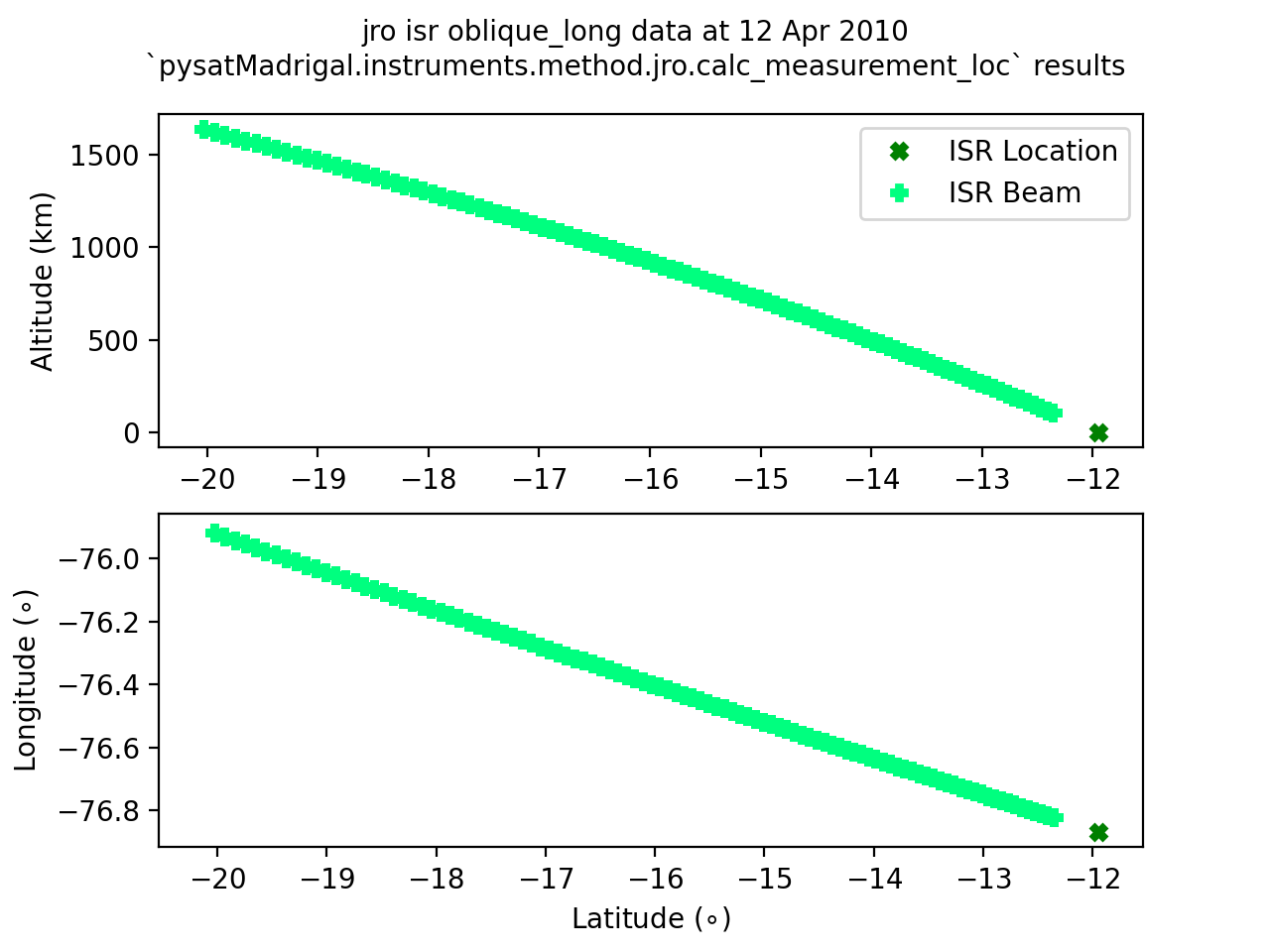Calculate JRO ISR Beam Location
For measurements made using a single beam, it may be more appropriate to account
for the changes in beam direction with altitude when determining the measurement
location instead of using the location of the radar. The method
instruments.methods.jro.calc_measurement_loc() (see JRO)
uses the beam azimuth and elevation measurements to determine the geodetic
latitude and longitude.
This method is designed to be used with the JRO ISR data, and so assumes the
azimuths and elevations have data variable names with the format 'eldir#'
and 'azdir#' (where # is the beam number), or 'elm' and 'azm'.
It will modify the pysat.Instrument.data object by adding latitude
('gdlat#') and longitude ('gdlon#') variables for every beam that has
appropriately labeled azimuth and elevatiton data. If the azimuth and elevation
angle variables don’t specify the beam number, # will be set to '_bm'.
The easiest way to use instruments.methods.jro.calc_measurement_loc()
is to attach it to the JRO ISR pysat.Instrument as a custom
function
before loading data. If necessary, also download the desired data.
import datetime as dt
import pysat
import pysatMadrigal as pysat_mad
jro_obl = pysat.Instrument(inst_module=pysat_mad.instruments.jro_isr,
tag='oblique_long')
jro_obl.custom_attach(pysat_mad.instruments.methods.jro.calc_measurement_loc)
ftime = dt.datetime(2010, 4, 12)
if not ftime in jro_obl.files.files.index:
jro_obl.download(start=ftime)
The geographic beam locations will be present alongside the azimuths and elevations after the data is loaded.
jro_obl.load(date=ftime)
'gdlat_bm' in jro_obl.variables and 'gdlon_bm' in jro_obl.variables
The result of the above command should be True. To better visualize the
beam location calculation, let us plot the locations of the beam range gates
and the radar location.
import matplotlib.pyplot as plt
# Initialize the figure and axes
fig = plt.figure()
ax_alt = fig.add_subplot(211)
ax_geo = fig.add_subplot(212)
# Plot the altitude data
ax_alt.plot(jro_obl['gdlatr'], 0.52, 'X', color='green')
ax_alt.plot(jro_obl['gdlat_bm'], jro_obl['gdalt'], 'P', color='springgreen')
# Plot the lat/lon data
ax_geo.plot(jro_obl['gdlatr'], jro_obl['gdlonr'], 'X', color='green')
ax_geo.plot(jro_obl['gdlat_bm'], jro_obl['gdlon_bm'], 'P',
color='springgreen')
# Format the figure
ax_geo.set_xlabel('Latitude ($\circ$)')
ax_geo.set_ylabel('Longitude ($\circ$)')
ax_alt.set_ylabel('Altitude (km)')
ax_alt.legend(['ISR Location', 'ISR Beam'], fontsize='medium')
fig.suptitle('{:s} {:s} {:s} data at {:s}\n`pysatMadrigal.instruments.method.jro.calc_measurement_loc` results'.format(
jro_obl.platform, jro_obl.name, jro_obl.tag,
jro_obl.index[0].strftime('%d %b %Y')), fontsize='medium')
